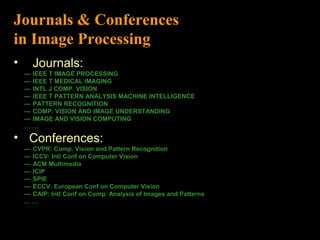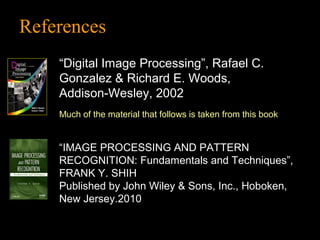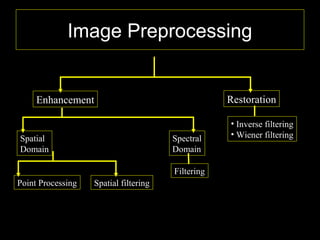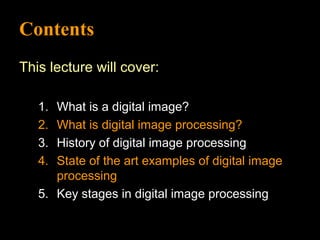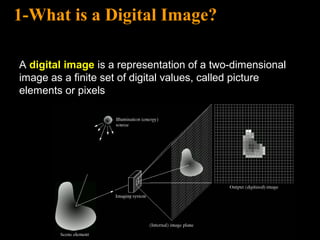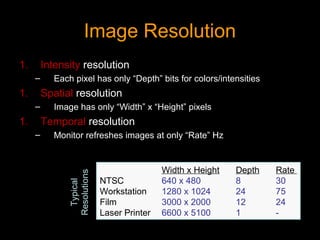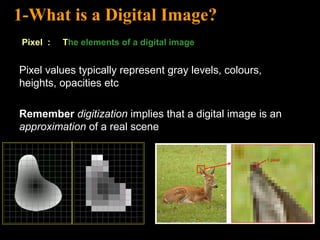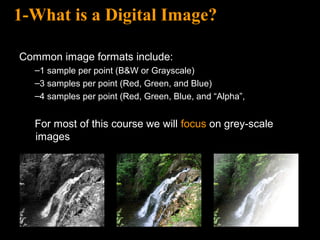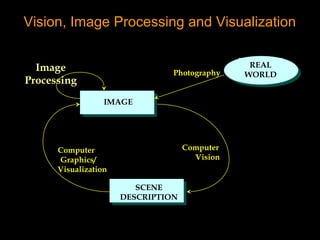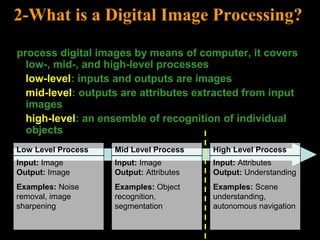Lecture 1 introduction
- 1. Lecture 1 Digital Image Processing: Introduction Lecturer: Dr. Faisel Ghazee Mohammed Email: faisel@scbaghdad.edu.iq faiselgm73@gmail.com 2010-2011 All rights reserved
- 2. Grading Article Reading and Presentation: 10% Homework: 10% Exam: 30% Practical: 50% Total: 100% Extra Credits: 50%. If the method and experimental results of your project achieve the state of the art, you will earn the extra 50% credits. Introduction to the course
- 3. Article Reading and Projects 1. Medical image analysis (MRI/PET/CT/X-ray tumor detection/classification) 2. Face, fingerprint, and other object recognition 3. Image and/or video compression 4. Image segmentation and/or denoising 5. Digital image/video watermarking/steganography and detection 6. Whatever youŌĆÖre interested ŌĆ” Introduction to the course
- 4. ŌĆó Evaluation of article reading and project ŌĆō Report ’āśArticle reading ŌĆö Submit a survey of the articles you read and the list of the articles ’āśProject ŌĆö Submit an article including introduction, methods, experiments, results, and conclusions ŌĆö Submit the project code, the readme document, and some testing samples (images, videos, etc.) for validation ŌĆō Presentation Introduction to the course
- 5. ŌĆó Journals: ŌĆö IEEE T IMAGE PROCESSING ŌĆö IEEE T MEDICAL IMAGING ŌĆö INTL J COMP. VISION ŌĆö IEEE T PATTERN ANALYSIS MACHINE INTELLIGENCE ŌĆö PATTERN RECOGNITION ŌĆö COMP. VISION AND IMAGE UNDERSTANDING ŌĆö IMAGE AND VISION COMPUTING ŌĆ” ŌĆ” ŌĆó Conferences: ŌĆö CVPR: Comp. Vision and Pattern Recognition ŌĆö ICCV: Intl Conf on Computer Vision ŌĆö ACM Multimedia ŌĆö ICIP ŌĆö SPIE ŌĆö ECCV: European Conf on Computer Vision ŌĆö CAIP: Intl Conf on Comp. Analysis of Images and Patterns ŌĆ” ŌĆ” Journals & Conferences in Image Processing
- 6. References ŌĆ£Digital Image ProcessingŌĆØ, Rafael C. Gonzalez & Richard E. Woods, Addison-Wesley, 2002 Much of the material that follows is taken from this book ŌĆ£IMAGE PROCESSING AND PATTERN RECOGNITION: Fundamentals and TechniquesŌĆØ, FRANK Y. SHIH Published by John Wiley & Sons, Inc., Hoboken, New Jersey.2010
- 7. DIP: Topics
- 8. Image Preprocessing Enhancement Restoration Spatial Domain Spectral Domain Point Processing Spatial filtering Filtering ŌĆó Inverse filtering ŌĆó Wiener filtering
- 9. Contents This lecture will cover: 1. What is a digital image? 2. What is digital image processing? 3. History of digital image processing 4. State of the art examples of digital image processing 5. Key stages in digital image processing
- 10. A digital image is a representation of a two-dimensional image as a finite set of digital values, called picture elements or pixels 1-What is a Digital Image?
- 11. Image Resolution 1. Intensity resolution ŌĆō Each pixel has only ŌĆ£DepthŌĆØ bits for colors/intensities 1. Spatial resolution ŌĆō Image has only ŌĆ£WidthŌĆØ x ŌĆ£HeightŌĆØ pixels 1. Temporal resolution ŌĆō Monitor refreshes images at only ŌĆ£RateŌĆØ Hz Width x Height Depth Rate NTSC 640 x 480 8 30 Workstation 1280 x 1024 24 75 Film 3000 x 2000 12 24 Laser Printer 6600 x 5100 1 - Typical Resolutions
- 12. Sources of Error 1. Intensity quantization ŌĆō Not enough intensity resolution 1. Spatial aliasing ŌĆō Not enough spatial resolution 1. Temporal aliasing ŌĆō Not enough temporal resolution E: denote to error I(x,y): denote to original pixel value P(x,y): denote to Processed pixel value
- 13. Pixel values typically represent gray levels, colours, heights, opacities etc Remember digitization implies that a digital image is an approximation of a real scene 1 pixel 1-What is a Digital Image? Pixel : The elements of a digital image
- 14. Common image formats include: ŌĆō1 sample per point (B&W or Grayscale) ŌĆō3 samples per point (Red, Green, and Blue) ŌĆō4 samples per point (Red, Green, Blue, and ŌĆ£AlphaŌĆØ, For most of this course we will focus on grey-scale images 1-What is a Digital Image?
- 15. Vision, Image Processing and Visualization REAL WORLD IMAGE SCENE DESCRIPTION Image Processing Computer Graphics/ Visualization Computer Vision Photography
- 16. Low Level Process Input: Image Output: Image Examples: Noise removal, image sharpening Mid Level Process Input: Image Output: Attributes Examples: Object recognition, segmentation High Level Process Input: Attributes Output: Understanding Examples: Scene understanding, autonomous navigation process digital images by means of computer, it covers low-, mid-, and high-level processes low-level: inputs and outputs are images mid-level: outputs are attributes extracted from input images high-level: an ensemble of recognition of individual objects 2-What is a Digital Image Processing?
- 17. Image Acquisition Image Restoration Morphological Processing Segmentation Representation & Description Image Enhancement Object Recognition Problem Domain Colour Image Processing Image Compression 5-Key Stages in Digital Image Processing
- 18. END Of Lecture 1
Editor's Notes
- #11: Real world is continuous ŌĆō an image is simply a digital approximation of this.
- #17: Give the analogy of the character recognition system. Low Level: Cleaning up the image of some text Mid level: Segmenting the text from the background and recognising individual characters High level: Understanding what the text says





